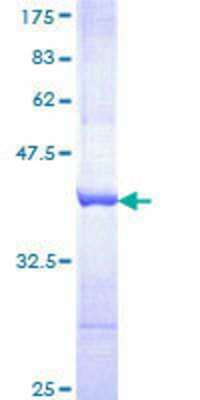PSD-95: Proteins and Enzymes
PSD-95 (postsynaptic density-95 kDa; also SAP90) is a 95 kDa member of the MAGUK (membrane-associated guanylate kinase) family of molecules. It is a multidomain protein that serves as a scaffold, or anchor, for the organization of structural and signal transduction pathways in neurons. PSD-95 is capable of forming multimers, generating large complexes that impact the size and strength of synapses. The PSD-95 molecule is highly conserved across species, being 99% amino acid identical, human to rodent.
In rats, PSD-95 is 724 amino acids (aa) in length, and contains three consecutive 80 aa PDZ domains (aa 65 - 393), followed by an SH3 domain (aa 432 - 490) and a C-terminal guanylate kinase domain (aa 534 - 709). The PZD (PSD/Discs-large/ZO-1) domains in PSD-95 are globular structures that bind NMDA receptor subunits and neuroligin (a transmembrane intercellular neuron adhesion molecule). The SH3 domain binds proline-rich motifs on enzymes, and may interact with either kainate receptor subunits or SHANK, another scaffold protein. The guanylate kinase binds microtubules-associated protein and kainate receptor subunits. PSD-95 is regulated by palmitoylation on C3 and C5. When present, palmitate promotes AMPA receptor clustering and neurotransmission. Phosphorylation also regulates PSD-95 activity. Both S290 and S295 are known to be phosphorylated. These modifications are suggested to retain PSD-95 in the synapse and/or regulate PZD interactions with target proteins.
2 results for "PSD-95 Proteins and Enzymes" in Products
2 results for "PSD-95 Proteins and Enzymes" in Products
PSD-95: Proteins and Enzymes
PSD-95 (postsynaptic density-95 kDa; also SAP90) is a 95 kDa member of the MAGUK (membrane-associated guanylate kinase) family of molecules. It is a multidomain protein that serves as a scaffold, or anchor, for the organization of structural and signal transduction pathways in neurons. PSD-95 is capable of forming multimers, generating large complexes that impact the size and strength of synapses. The PSD-95 molecule is highly conserved across species, being 99% amino acid identical, human to rodent.
In rats, PSD-95 is 724 amino acids (aa) in length, and contains three consecutive 80 aa PDZ domains (aa 65 - 393), followed by an SH3 domain (aa 432 - 490) and a C-terminal guanylate kinase domain (aa 534 - 709). The PZD (PSD/Discs-large/ZO-1) domains in PSD-95 are globular structures that bind NMDA receptor subunits and neuroligin (a transmembrane intercellular neuron adhesion molecule). The SH3 domain binds proline-rich motifs on enzymes, and may interact with either kainate receptor subunits or SHANK, another scaffold protein. The guanylate kinase binds microtubules-associated protein and kainate receptor subunits. PSD-95 is regulated by palmitoylation on C3 and C5. When present, palmitate promotes AMPA receptor clustering and neurotransmission. Phosphorylation also regulates PSD-95 activity. Both S290 and S295 are known to be phosphorylated. These modifications are suggested to retain PSD-95 in the synapse and/or regulate PZD interactions with target proteins.
| Applications: | WB, ELISA, Func, MA, AP |
| Applications: | WB, ELISA, MA, AP |

![SDS-PAGE: Recombinant Human PSD-95 GST (N-Term) Protein [H00001742-P01] SDS-PAGE: Recombinant Human PSD-95 GST (N-Term) Protein [H00001742-P01]](https://resources.bio-techne.com/images/products/Recombinant-Human-PSD-95-Protein-SDS-Page-H00001742-P01-img0002.jpg)
